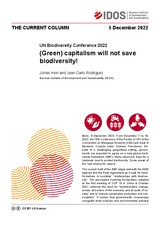UN Biodiversity Conference 2022
(Green) capitalism will not save biodiversity!
Hein, Jonas / Jean Carlo RodriguezThe Current Column (2022)
Bonn: German Institute of Development and Sustainability (IDOS), The Current Column of 5 December 2022
Bonn, 5 December 2022. From December 7 to 19, 2022, the 15th Conference of the Parties (COP) of the Convention on Biological Diversity (CBD) will meet in Montreal, Canada under Chinese Presidency. Despite of a challenging geopolitical setting, governments are expected to agree on a new global biodiversity framework (GBF). Many observers hope for a landmark deal to protect biodiversity. Some speak of the “last chance for nature”.
The current draft of the GBF aligns well with the 2030 Agenda and the Paris Agreement as it calls for transformations in societies’ “relationships with biodiversity”. The associated Kunming Declaration, adopted at the first meeting of COP 15 in China in October 2021, stresses the need for “transformative change, across all sectors of the economy and all parts of society” and to “ensure sustainable production and consumption”. It seems that governments increasingly recognize what scholars and environmental activists have argued since decades: we need to “phase out unsustainable production and consumption”.
Notwithstanding the apparent consensus among many policy makers, conservation practitioners and environmental NGOs, the draft agreement consists of a mostly technocratic set of statements and goals. This is not a surprise for those familiar with the language of multilateral UN documents but it is one of the weaknesses of the prospective GBF: The political economy of conservation and habitat destruction was either not taken into account or got lost in translation. Yet, governments have to take the progressive wording of the Kunming Declaration seriously and acknowledge that we need a socio-ecological transformation to tackle biodiversity loss. Without fundamentally questioning our economic system, the success of the new GBF remains highly unlikely.
Scientific evidence is clear, alarming and disappointing. Despite of a growing number of protected areas and market-based instruments biodiversity dropped worldwide by 68% since 1970. Yet, infinite economic growth remains the dominant paradigm despite of devastating impacts on ecosystems. Moreover, complex value chains and the associated ability to separate commodities such as timber from their supporting context (e.g. rainforest) make biodiversity loss difficult to grasp in our day-to-day lives. The losses occur elsewhere and remain mostly invisible to us.
The non-human living beings remain outside our communities of justice. They are in most cases only relevant when serving our interests (e.g. as food or for pollination), or as factors of cost-benefit calculations and required offsetting measures for instance for large infrastructure projects. A German metropolitan newspaper, for example, once heavily criticized the opponents of the deepening and expansion of the shipping channel of the Elbe for assigning more value to endangered species such as the Elbe water dropwort than to jobs and tax revenues. Thus, biodiversity conservation seems to be fine as long it is not impacting our economies. Hence, for how many jobs can we accept species extinction? Business as usual will not end biodiversity loss.
What is needed to halt and reverse biodiversity loss and to implement the new GBF successfully? First, we have to acknowledge that our economic system and its inherent and permanent need for expansion leads to increased resource use, habitat destruction and biodiversity loss. Consequently, the GBF requires a socio-ecological transformation towards an economy that does not require permanent growth of production and consumption. Economic exchange in such a society should not serve capital accumulation but rather a good living based on non-destructive societal relations with biodiversity. This requires an average reduction of production and consumption in some sectors of our economy and it will require growth in sectors such as in the renewable energy, education, health and care sector. Such a transformation would put wellbeing of people, use values and ecosystems first and not capital accumulation and profit. Thereby, we could reduce the underlying drivers of biodiversity loss.
Second, we have to change biodiversity conservation. This implies to go beyond market-based instruments, cost-benefit approaches to conservation and protected areas that exclude people from nature. Conservation policies should acknowledge the role of indigenous people and local communities (IPLCs)) and should support those actors that have contributed to biodiversity conservation since centuries. An unconditional conservation basic income is a promising tool. It would be paid to people living in important areas for biodiversity conservation and would cover their basic needs. The payments could be considered as a form of “reparation” to IPLCs as they have often been evicted from traditional lands in the course of the implementation of new protected areas.



